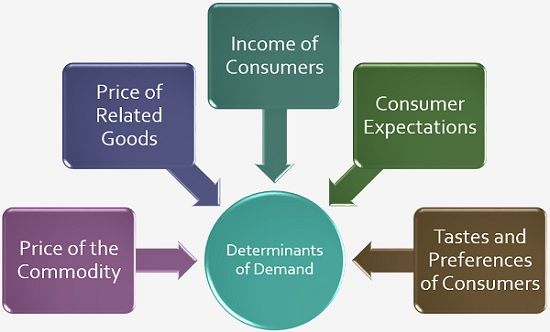Definition: The word ‘demand’ is used to imply the quantity (how much) of a given commodity or service, the consumers are willing and able to buy, in a market during the particular period of time, at any price, or at any income or at any price of related goods.
Demand is not just the desire for the commodity, rather when the desire is supported by the means to purchase, the willingness of the consumer to use those means to buy the commodity and purchasing power of the consumer, then only it is termed as demand.
Determinants of Demand
- Price of the Commodity: Other things being constant, there is an inverse relationship between the commodity’s price and its demand, i.e. an increase in the price of the commodity, results in the decrease in its demand, and vice versa. For instance: The rise in the price of detergent produced by A Ltd. will decrease its demand, as the price-sensitive consumers may choose detergent produced by some other company over the detergent produced by A Ltd.
- Price of Related Goods: Related goods refer to the goods whose change in price may change the quantity demanded of a commodity. The related goods are classified as:
- Complementary Goods: The products which are used or taken together or simultaneously are called complementary goods. For instance: Shampoo and Conditioner wherein a fall in the price of Shampoo leads to the rise in the demand of Conditioner.
- Competing Goods: When two commodities share similar wants and can be used interchangeably are called as Competing Goods or Substitute Goods. For instance: Soap or Shower Gel wherein a fall in the price of Shower Gel results in the fall in quantity demanded of its Soap. So, there is a direct relationship between demand for the commodity and the price of its substitutes.
- Income of the Consumer: Other things remain constant, the income level of the consumer also influences the demand for a commodity, as the buying power of the consumer depends on the income level itself.The nature of consumer goods decides the nature of the relationship between income and the quantity demanded. As the income of the consumer increases, the consumer wants more of a given commodity, but this is not true in all the situations, as in case of inferior goods, where the rise in the level of income leads to decrease in its demand, because the consumer switch to better quality product, which they can afford after the rise in their income.
- Consumer Expectations: When the price of a particular commodity, is expected to rise in the near future, the demand for that good, goes up, for that particular time. In the same way, when the price of a commodity is expected to fall, the demand for it usually comes down, as the customers will postpone the purchase. For instance: If the gold prices are expected to rise in the coming time, then its demand increases for that duration.
- Tastes and Preferences of Consumer: The tastes and preferences of the consumer also have a significant effect on the demand for its commodity. We all know that when something is in fashion, it is high in demand, which may change over a period of time. For instance: With the introduction of 5G technology handsets in the market, the demand for 4G smartphones has been reduced.
- Demonstration Effect: A person’s demand for a particular good or service is also influenced by his seeing his relative, friend, colleagues, neighbours consuming it. There are two main reasons behind it, i.e. by seeing the other person consuming it, the individual also gets the desire to consume the same, or he/she thinks that if his relative can afford it, then he/she can also afford it. This is called a Demonstration Effect.
- Snob Effect: The opposite of the demonstration effect is the snob effect, which says that if a commodity is common among all the people, some people will stop using it, leading to the decrease in overall demand.
- Veblen Effect: Goods which are high in price is a status symbol for rich people and so are consumed by that class only, to fulfil their need for prestige. This is called a Veblen Effect.
In addition to the above factors, there are factors like the size of the population, the composition of the population, national income and its distribution, which also affects the demand for a commodity.


Leave a Reply